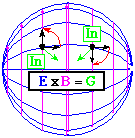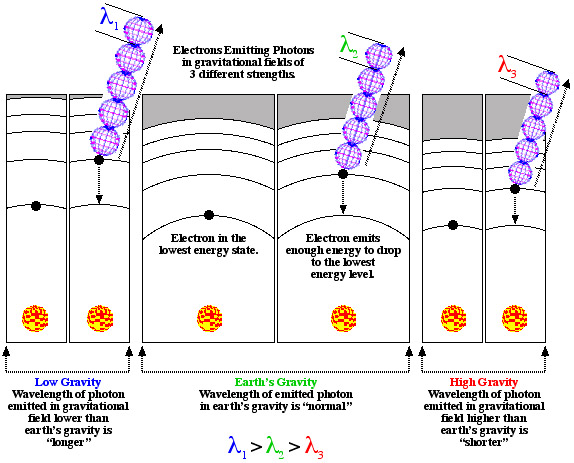Neither you nor I will ever go to a star, weigh a star, go inside a star, grab a piece of star, or in any way analyze a star firsthand. The main way astronomers analyze stars is by looking at them. Specifically, most useful information about stars comes from analyzing the light from the star. Spectroscopy is the analysis of light by separating it into different wavelengths. The problem with spectroscopy is this:
Does the atoms of light in distant stars
-- even in our sun --
give off light in the exact same way as the atoms here on earth?
The answer is,. I believe, no!
When an electron is decelerated or accelerated it can give off a photon. An electron can absorb a photon. The Ball-of-Light Particle describes exactly how photons combine with electrons and how they are emitted from electrons. Below is an animation of a photon with all three fields: electric, magnetic, and gravitational.
Below is a graphic of an electron.

If the electron and the photon are polarized correctly -- so the fields attract rather than repel (See Table B all four quadrants for polarizations) -- then the can combine. The electron and photon are automatically polarized when the photon is emitted.
When an electron and a photon interact it can happen in one of two main situations
When a photon interacts with an electron that is or becomes bound in an atom it can happen in three ways:
When an electron absorbs a photon, it will be bumped up an energy level as shown in the following graphic.

If the electron absorbs a photon with enough energy, then the electron may be bumped out of orbit of the nucleus. This is just one way a nucleus may be ionized. (The Ball-of-Light Particle Model predicts all elementary particles are created as ions. The nuclei and their electrons then combine. An atom is never created from scratch.)
When an electron emits a photon, it will drop down an energy level as shown in the following graphic.

The greater fall in energy levels, the more energy the photon will have.
Scientists have studied the spectra of just about every possible energy level, in just about every atom if not all of them. They have found that every jump in energy levels -- up or down -- has a specific energy associated with it. The photon emitted or absorbed has a specific wavelength to it. This is what led to quantum physics. The jumps in energy occur with specific multiples of energy, or quanta of energy.
Astronomers study the spectra of star by comparing the spectra of the known atoms on earth with the spectra of the stars. They can spot, for example, if a star has calcium, iron, or Technetium in them.
If a star is moving away from, or towards earth, then the spectra of the atomic elements will be shifted away from the wavelengths here on earth. Astronomers think this is great because then they think they "know" for sure how fast the astronomical object is moving away from, or towards earth.
The problem is, they are wrong. Astronomers, I believe, are making an error in their measurements of comparing the Doppler Shift of the spectrum of the astronomical objects they study. According to the Ball-of-Light Particle Model, gravity is not a constant. It can rise and fall depending on how fast an object is moving with respect to an expanding sphere of light. Why does this cause a problem? If an atom is experiencing a larger or smaller gravitational field than our standards here on earth, then the photons emitted or absorbed will be shifted from we think they are. For example, some of the Doppler shift astronomers attribute to the particle could be a result of higher or lower gravity, not higher or lower velocity with respect to earth. This is shown in the following graphic.

When astronomers measure the Doppler shift of a spinning galaxy seen edge-on, they will compare the side of the galaxy moving towards earth with the center of the galaxy. They will compare the side of the galaxy moving away from earth to the same center of the galaxy. With respect to the center of the galaxy, an error could occur. We might think that the entire galaxy is moving towards or away from us at the wrong speed. With respect to the sides of the galaxy, an error could occur. The gravitational field in the entire galaxy could be higher or lower than in our location of the Milky Way galaxy, leading to an error in how fast the portions of the galaxy are spinning.
Scientists believe "Dark Matter" exists because the spin velocities of galaxies appears to be too high. They appear that they should fly apart if they used the same gravitational force law as we use in our solar system. (See my page on Gravity.) I do not believe they can yet claim "Dark Matter" exists if they: do not know what "time" is; if they can not prove that stars are burning via nuclear fusion (the neutrino deficit problem still exists); and they have, I believe, a systemic error in how they use spectroscopy.
"Dark Energy" is a fictitious energy that is supposedly making the universal explosion called the Big Bang accelerate. I do not believe astronomers can yet claim that "Dark Energy" exists if they: do not know what "time" is; if can theories of how supernova occur have contradictions in them (They can not, for example, explain the rings in supernova 1987A.); if they can explain the mechanism of pulsating stars; if they can not explain the spectrum of continuous spectrum of white dwarfs; and many, many other facts.
When astronomers sometimes explain their bizarre theories, without fundamental physical theories to back them up, they sometimes claim that there is no "alternative," there is no "alternative theory." Yes there is.